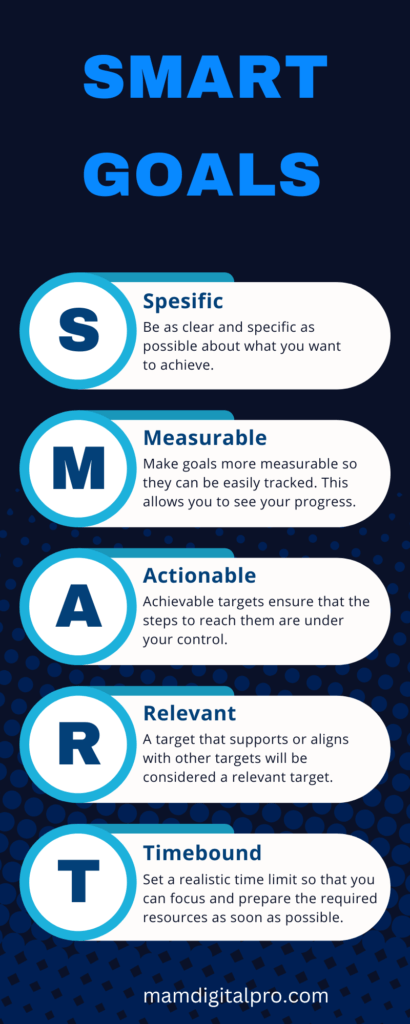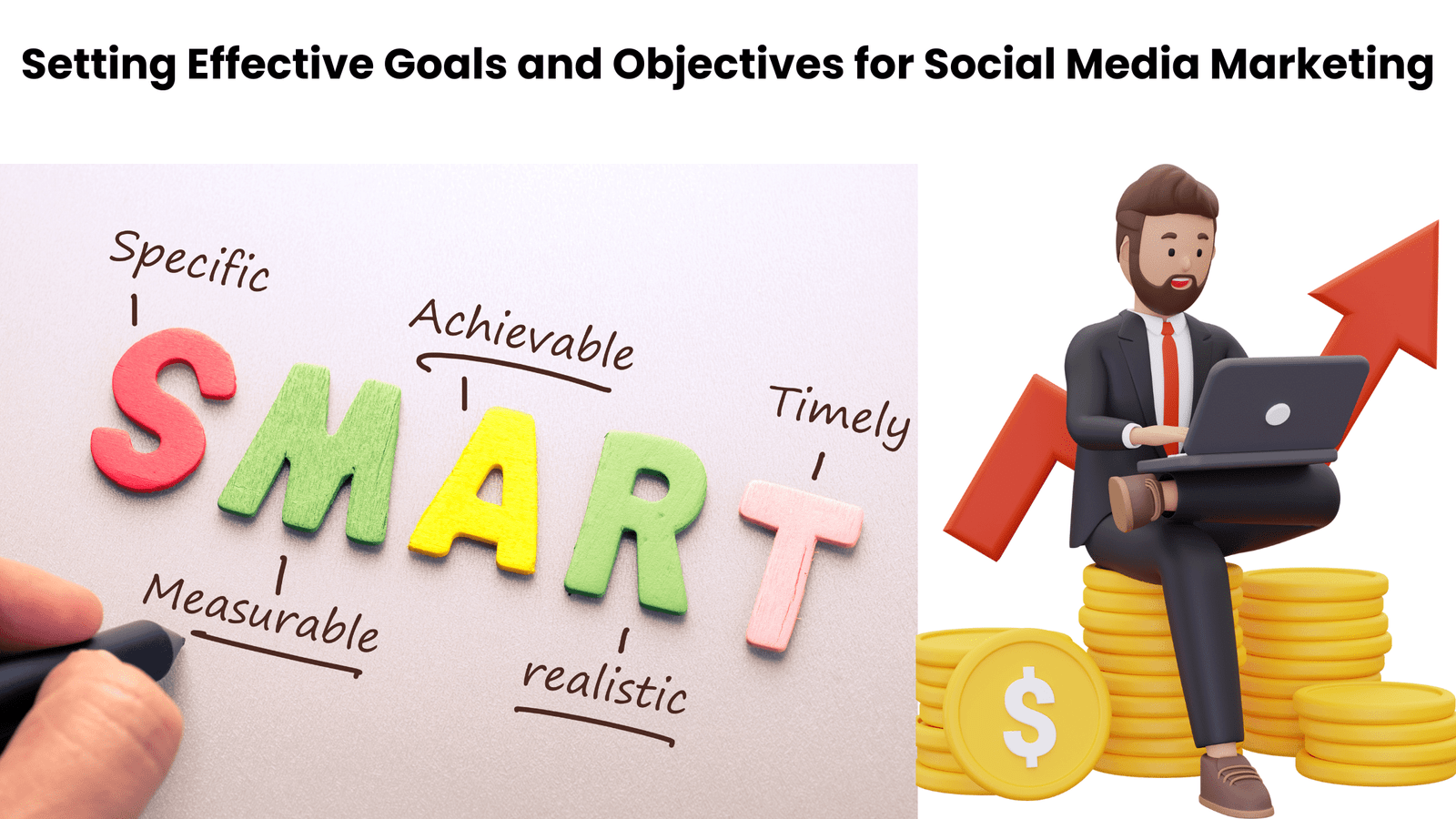Clearly defined goals and objectives are essential for ensuring your social media marketing strategy delivers tangible value for your business. Social media marketing has become integral to any successful marketing strategy in today’s digital landscape. However, achieving the desired results from social media campaigns requires careful planning and goal setting. Setting clear and measurable goals and objectives is essential for driving meaningful engagement, building brand awareness, and boosting your business’s bottom line.
This blog post will explore the importance of setting goals and objectives for social media marketing. We will explore how to create SMART goals, define key performance indicators (KPIs), and provide examples to help you develop a strategic and effective social media marketing plan. By the end, you will have the tools and knowledge to set achievable goals that align with your overall marketing objectives and drive success in your social media endeavors.
Why does Setting Goals and Objectives Matter in Social Media Marketing?
Setting goals and objectives in social media marketing is crucial because:
- They provide direction and purpose to your campaigns.
- Clear goals enable you to focus your efforts on specific outcomes, making it easier to measure success and identify areas for improvement.
- Well-defined goals help to align your social media strategy with your overall marketing objectives, ensuring your efforts contribute to your business’s growth.
- Setting goals and objectives helps to establish realistic expectations. It allows you to gauge the feasibility of your strategies and provides a benchmark for evaluating your progress.
- By setting measurable goals, you can track your performance over time and make data-driven adjustments to optimize your campaigns.
How to Identify Social Media Goals Based on Insights?
The first step is identifying the goals that make the most sense for your brand and audience. It requires digging into critical insights:
Social Media Analytics: Analyze historical performance across your social platforms and campaigns using social media analytics. This way, we can determine what has worked well and what opportunities exist.
Audience Research: Use surveys, interviews, and social listening to understand your audience’s motivations and needs. Uncover problems you can help solve.
Competitor Analysis: Study what goals competitors prioritize in their social strategies and where gaps may be filled.
Business Objectives: Connect with sales, marketing, and leadership teams to understand broader business goals to align with.
Performance Data: Identify optimization opportunities by incorporating website traffic, lead generation, and sales data.
Marketing Calendar: Factor in launches, campaigns, and initiatives planned for the year that social media can support.
With these insights, you can brainstorm potential social media goals that map to business needs, audience wants, and growth opportunities.
Creating SMART Goals for Social Media Marketing
When setting goals for social media marketing, it is essential to follow the SMART framework. SMART stands for Specific, Measurable, Achievable, Relevant, and Time-bound. Let’s break down each element:
- Specific: Clearly define your goals with thorough details. For instance, instead of saying, “increase social media followers,” specify, “increase Instagram followers by 20% in three months.”
- Measurable: Set goals that can be quantified. It allows you to track progress and measure success. Examples include increasing website traffic by a certain percentage, achieving a specific number of post engagements, or generating a certain amount of leads.
- Achievable: Ensure your goals are realistic and attainable based on your available resources, budget, and industry benchmarks. While it’s great to aim high, setting unattainable goals can lead to frustration and demotivation.
- Relevant: Align your social media goals with your overall marketing objectives. Identify how each goal contributes to your brand’s growth, customer acquisition, and awareness. Please make sure they are relevant to your target audience and business goals.
- Time-bound: Set deadlines for your goals to create a sense of urgency and accountability. It helps you stay focused and allows for timely evaluation and adjustments. Examples include increasing conversion rates by 15% within six months or launching a social media influencer campaign in the next quarter.

Examples of Social Media Goals and Objectives
To illustrate how to create effective goals and objectives, let’s explore some common scenarios:
- Increase Brand Awareness:
Goal: Increase Facebook brand reach by 30% within six months.
Objective: Increase post impressions and engagement rates through strategic content creation and paid advertising campaigns.
- Boost Customer Engagement:
Goal: Increase Instagram post engagement rate by 20% in three months.
Objective: Encourage user-generated content, run interactive contests, and respond promptly to comments and messages.
- Drive Website Traffic:
Goal: Increase referral traffic from social media channels by 25% in four months.
Objective: Create compelling content with clear call-to-actions, optimize landing pages, and implement social media advertising campaigns.
- Generate Leads:
Goal: Achieve 100 qualified leads from social media campaigns within three months.
Objective: Develop lead generation forms, run targeted ad campaigns, and offer valuable gated content to capture user information.
- Improve Customer Satisfaction:
Goal: Achieve a 90% positive sentiment rate in social media mentions within six months.
Objective: Enhance customer service responsiveness, actively monitor social media conversations, and address customer feedback promptly.
Conclusion :
Social media marketing success is primarily determined by setting goals and objectives. The SMART framework can help you align your marketing goals with your business objectives. You can create a strategic roadmap that drives meaningful engagement, builds brand awareness, and ultimately contributes to your business’s growth. Practical goal setting involves continuous monitoring and adjustment based on data-driven insights. Regularly assess your progress, analyze metrics, and adapt your strategies accordingly. With well-defined goals and a comprehensive understanding of your target audience, you can leverage the power of social media marketing to propel your business forward.
FAQs:
1: Why is setting goals and objectives important in social media marketing?
Setting goals and objectives in social media marketing is crucial because they provide your campaign’s direction, focus, and purpose. Clear goals enable you to measure success, identify areas for improvement, and align your social media strategy with your overall marketing objectives. Additionally, well-defined goals help establish realistic expectations and provide a benchmark for evaluating your progress.
2: What is the difference between goals and objectives?
Goals are the overarching achievements you want your social media marketing to accomplish. Objectives are the specific, measurable steps you need to take to reach those goals. For example, a goal may be to increase brand awareness. Objectives to achieve that goal could include growing Twitter followers by 15% and getting 250 social shares per campaign.
3: How often should I review and revise my social media goals?
It’s essential to revisit your social media goals at least quarterly to assess progress and whether adjustments need to be made. Key factors impacting goals include audience research insights, competitive intelligence, new company objectives, platform algorithm changes, and performance data. By regularly updating your goals, you can maximize their relevance and effectiveness.
4. What is the SMART framework for setting goals?
The SMART framework is widely used to help set effective and meaningful goals. SMART is an acronym that stands for:
- Specific – Goals should be clear, concise, and detailed. They should answer the “What, Why, and How” of the goal.
- Measurable – Goals should be quantifiable and have concrete criteria for measuring progress and success.
- Achievable – Goals should be realistic and attainable within available resources and capabilities.
- Relevant – Goals should align with overall objectives and priorities.
- Time-Bound – Goals should have a clearly defined time frame, including a deadline or schedule.
5. How do you set a specific goal for social media marketing?
- Identify a clear objective like increasing brand awareness, generating leads, or growing your audience.
- Define numeric metrics like percentage increase in followers, engagement rate, click-through rate, etc.
- Specify target audiences like teenagers, millennials, women, etc.
- List platforms like Instagram, Facebook, YouTube, etc.
- Example: Increase Instagram followers among teenagers by 10% in 3 months.
6. How do you set measurable goals for social media?
- Use numeric values for goals like percentage increase, number of shares/likes, etc.
- Identify quantitative metrics like impressions, reach, and click-through rate.
- Track progress periodically by monitoring analytics.
- Set performance benchmarks like cost-per-click conversion rates.
- Conduct surveys and polls to quantify sentiment or perceptions.
7. How can you ensure social media goals are relevant?
- Align goals with overall business objectives, target audience needs, and marketing strategy.
- Focus goals on driving desired outcomes like sales, leads, brand-building, etc.
- Prioritize goals that maximize impact and steer social media efforts.
- Regularly review relevance as an audience, platform algorithms, and trends evolve.
8. Why is setting a timeline for social media goals important?
- It creates a sense of urgency and encourages productivity.
- Allows tracking progress at specific intervals.
- Helps schedule tasks and allocate resources efficiently.
- Drives strategy adjustment if goals are not met as per schedule.
- Keeps efforts focused on consistent execution within deadlines.
9. What are some best practices for writing SMART social media goals?
- Use action verbs like increase, reduce, grow, acquire, etc.
- Have only one metric per goal. Don’t combine multiple metrics.
- Focus on outcome rather than activities like post 4 times a week.
- Have both macro goals for the long term and micro goals for the short term.
- Define process goals on how to achieve outcome goals.
- Have numerical goals for essential metrics like engagement rate, click-through rate, etc.
10. How often should you review and revise social media goals?
Monthly – Evaluate short-term progress and make tactical adjustments.
Quarterly – Assess medium-term goal progress and realign efforts.
Annually – Strategic review of long-term goal achievement. Set new goals.
Ongoing – Monitor goal relevance as audience, algorithms, and competition evolve.
9. What are some common social media goals for businesses?
– Increase brand awareness and reach
– Grow followers and build community
– Generate qualified leads or sales
– Increase engagement and website traffic
– Improve brand sentiment and loyalty
– Reduce customer service costs
– Drive app installs and activations
10. What are some tips for successfully achieving social media goals?
- Make goals public to create accountability.
- Break down big goals into smaller milestones.
- Focus on quality over vanity metrics.
- Analyze data insights regularly to guide efforts.
- Adapt strategy if goals are not met.
- Automate processes through tools like HootSuite.
- Offer incentives for goal achievement.
- Partner with influencers to expand reach.

